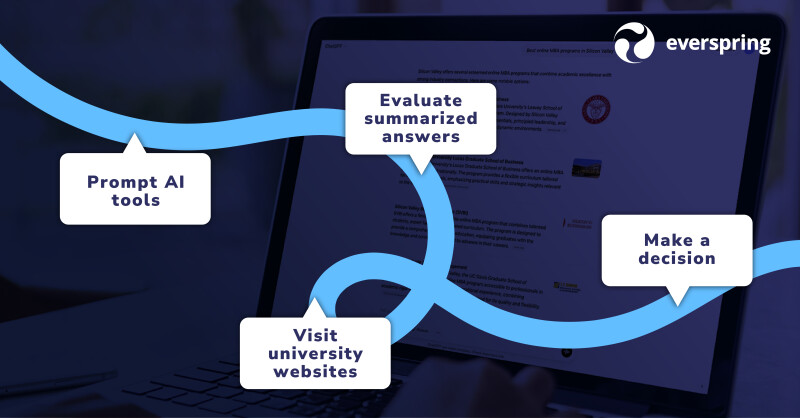For years, university marketing teams have focused on making their website the centerpiece of their digital strategy—a discovery hub, a lead generator, a storytelling platform.
But here’s the paradox no one’s talking about: Your website is no longer where prospective students meet you. It’s the last mile, not the first touchpoint.
Students Are No Longer Starting with Your Website—They’re Starting with AI
Thanks to rapid adoption of AI tools, today’s students don’t begin their search by typing your university’s name into Google or browsing your homepage.
They ask AI-powered platforms instead. “What’s the best university for [X program]?” “Which schools offer flexible online options?” “What’s the campus culture like at [school]?”
Platforms like ChatGPT, Google’s AI Overviews, Perplexity, Claude, and others pull information from across the web to deliver immediate, summarized answers—often without the student ever needing to click through to a single website.
By the time they reach your site, they’ve already formed impressions, gathered facts, and compared you to competitors—all through AI.
The Last Mile Paradox in Action
This shift creates a paradox:
- You invest in website content, UX, and SEO to engage students.
- But the majority of student search behavior happens before they ever land on your site.
The website becomes the confirmation tool, not the discovery engine. It’s where students validate what AI has already told them—not where they start gathering information.
If your digital strategy is still focused solely on traditional SEO and website optimization, you’re leaving visibility—and enrollment opportunities—on the table.
The New Student Search Journey
Here’s what the modern student search path looks like:
- Prompt AI tools to get recommendations.
- Evaluate summarized answers and rankings (Google AI Overviews, ChatGPT summaries, etc.).
- Cross-check specific universities by visiting websites.
- Make decisions based on the AI-curated shortlist.
Notice: Your visibility in Step 1 & 2 determines whether you ever make it to Step 3.
What This Means for Your University
If your institution isn’t optimized for AI visibility—across platforms, content types, and schema—students may never even reach your website.
AI platforms are deciding which universities get recommended. And they don’t rely on your homepage—they rely on structured content, authority signals, and information they can easily parse and summarize.
This is where your digital strategy needs to evolve.
How to Solve the Last Mile Paradox: AI Search Optimization
To stay visible in the AI-driven search landscape, you need to optimize beyond your website:
- Ensure your content is structured in a way AI platforms can understand (think: schema markup, clear metadata, strong authority signals).
- Analyze how your university is appearing in AI platforms now—and how competitors are outperforming you.
- Align your content strategy to the real search behaviors of AI-native students, focusing on the questions and prompts they’re asking.
Ready to Take Control of Your AI Visibility?
At Everspring, we specialize in helping higher education institutions succeed in this evolving search environment.
Our Complete AI Search Strategy ensures your university shows up where students are searching—whether that’s Google, ChatGPT, or any emerging AI tool.
Because the last mile won’t matter if students never meet you in the first place.

